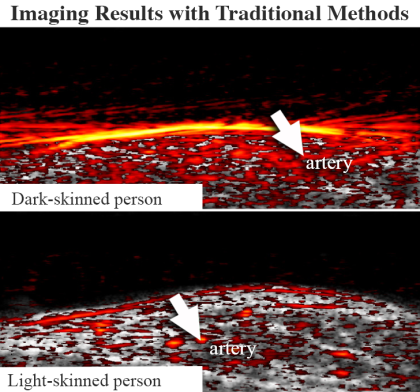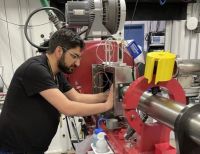- Name
- Roberto Molar Candanosa
- [email protected]
- Office phone
- 443-997-0258
- Cell phone
- 443-938-1944
Traditional medical imaging works great for people with light skin but has trouble getting clear pictures from patients with darker skin. A Johns Hopkins University–led team found a way to deliver clear pictures of anyone's internal anatomy, no matter their skin tone.
In experiments the new imaging technique produced significantly sharper images for all people—and excelled with darker skin tones. It produced much clearer images of arteries running through the forearms of all participants, compared to standard imaging methods where it was nearly impossible to distinguish the arteries in darker-skinned individuals.

"When you're imaging through skin with light, it's kind of like the elephant in the room that there are important biases and challenges for people with darker skin compared to those with lighter skin tones," said co-senior author Muyinatu "Bisi" Bell, the John C. Malone Associate Professor of Electrical and Computer Engineering, Biomedical Engineering, and Computer Science at Johns Hopkins. "Our work demonstrates that equitable imaging technology is possible."
The findings are newly published in the journal Photoacoustics.
"We show not only there is a problem with current methods but, more importantly, what we can do to reduce this bias," Bell said.
The findings advance a 2020 report that showed pulse oximeters, which measure oxygen rates in the blood, have higher error rates in Black patients.
"There were patients with darker skin tones who were basically being sent home to die because the sensor wasn't calibrated toward their skin tone," Bell said.
Bell's team created a new algorithm to process information from photoacoustic imaging, a method that combines ultrasound and light waves to render medical images. Body tissue absorbing this light expands, producing subtle sound waves that ultrasound devices turn into images of blood vessels, tumors, and other internal structures. But in people with darker skin tones, melanin absorbs more of this light, which yields cluttered or noisy signals for ultrasound machines.

The team was able to filter the unwanted signals from images of darker skin, in the way a camera filter sharpens a blurry picture, to provide more accurate details about the location and presence of internal biological structures.
The researchers are now working to apply the new findings to breast cancer imaging, since blood vessels can accumulate in and around tumors. Bell believes the work will improve surgical navigation as well as medical diagnostics.
"We're aiming to mitigate, and ideally eliminate, bias in imaging technologies by considering a wider diversity of people, whether it's skin tones, breast densities, body mass indexes—these are currently outliers for standard imaging techniques," Bell said. "Our goal is to maximize the capabilities of our imaging systems for a wider range of our patient population."
Other authors include Guilherme S.P. Fernandes, who was a visiting doctoral student at Johns Hopkins from University of São Paulo, Brazil, as well as João H. Uliana, Luciano Bachmann, Antonio A.O. Carneiro, and Theo Z. Pavan of University of São Paulo, Brazil.















